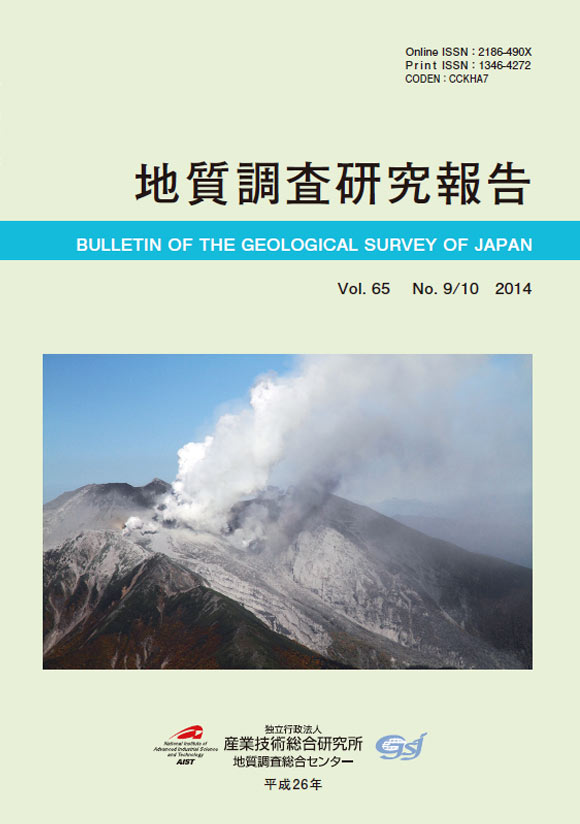All issues

Volume 65 (2014)
- Issue 11-12 Pages 129・・・
- Issue 9-10 Pages 105-
- Issue 7-8 Pages 85-
- Issue 5-6 Pages 67-
- Issue 3-4 Pages 23-
- Issue 1-2 Pages 1-
Volume 65, Issue 9-10
Bulletin of the Geological Survey of Japan
Displaying 1-3 of 3 articles from this issue
- |<
- <
- 1
- >
- >|
Report
-
Takeyuki Ueki2014 Volume 65 Issue 9-10 Pages 105-111
Published: December 03, 2014
Released on J-STAGE: February 07, 2015
JOURNAL FREE ACCESSThe Higher terrace deposits are distributed along the Katakami River of 4 km long, central Mie Prefecture, southwest Japan. The deposits are composed of angular to subangular clasts of sandstone and show normal paleomagnetic polarity. The age pf higher terrace deposits along the Katakami River is estimated to be before Middle Pleistocene. Possible cause of the deposition of the coarse sediments to form the higher terrace is rapid sediment supply from deep-seated slope failure.View full abstractDownload PDF (967K) -
Takahiro Yamamoto2014 Volume 65 Issue 9-10 Pages 113-116
Published: December 03, 2014
Released on J-STAGE: February 07, 2015
JOURNAL FREE ACCESSIn 2009, it was decided to make the Quaternary with its base at approximately 2.6 million years ago. Corresponding to this revision, Geological Survey of Japan, AIST has published VOLCANOES OF JAPAN (third edition), including Gelasian volcanoes (Nakano et al., 2013). Naramata caldera, which is located in the northeastern part of the Gunma Prefecture, NE Japan, is one of such volcanoes. This caldera is made up of rhyolitic pyroclastics and overlying lacustrine sediments filling a depression 2 km in diameter. Fission-track age of zircons from rhyolitic pyroclastics was determined as 2.1±0.2 Ma.View full abstractDownload PDF (1486K) -
Takahiro Yamamoto2014 Volume 65 Issue 9-10 Pages 117-127
Published: December 03, 2014
Released on J-STAGE: February 07, 2015
JOURNAL FREE ACCESSA phreatic eruption occurred on September 27, 2014 at Ontake Volcano, and was accompanied with pyroclastic density currents. This currents shot by the Chubu Regional Development Bureau’s camera at Takigoshi had the following characteristics. 1) Pyroclastic density currents occurred in two places (Jigokudani and western-flank) at the beginning of phreatic eruption. 2) The eruption column collapse height of the pyroclastic density currents did not exceed 300 m above the vents. 3) The front of the pyroclastic density currents traveling down the southern valleys moved at a speed of 8 to 20 m/s and reached 2 km from the vents. 4) Conspicuous secondary plume was observed rising from the current to ca. 2 km above the valleys; this suggests that the density currents possessed sufficient heat for the ash cloud to have risen due to its buoyancy. 5) However, no charring of trees was observed by helicopter observations. The Heim coefficient for the energy cone slope for the density currents is 0.45 to 0.55, when the column collapse height is 200 m.View full abstractDownload PDF (9810K)
- |<
- <
- 1
- >
- >|